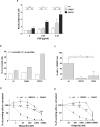Clinical consequences of BRCA2 hypomorphism
- PMID: 34504103
- PMCID: PMC8429460
- DOI: 10.1038/s41523-021-00322-9
Clinical consequences of BRCA2 hypomorphism
Abstract
The tumor suppressor FANCD1/BRCA2 is crucial for DNA homologous recombination repair (HRR). BRCA2 biallelic pathogenic variants result in a severe form of Fanconi anemia (FA) syndrome, whereas monoallelic pathogenic variants cause mainly hereditary breast and ovarian cancer predisposition. For decades, the co-occurrence in trans with a clearly pathogenic variant led to assume that the other allele was benign. However, here we show a patient with biallelic BRCA2 (c.1813dup and c.7796 A > G) diagnosed at age 33 with FA after a hypertoxic reaction to chemotherapy during breast cancer treatment. After DNA damage, patient cells displayed intermediate chromosome fragility, reduced survival, cell cycle defects, and significantly decreased RAD51 foci formation. With a newly developed cell-based flow cytometric assay, we measured single BRCA2 allele contributions to HRR, and found that expression of the missense allele in a BRCA2 KO cellular background partially recovered HRR activity. Our data suggest that a hypomorphic BRCA2 allele retaining 37-54% of normal HRR function can prevent FA clinical phenotype, but not the early onset of breast cancer and severe hypersensitivity to chemotherapy.
© 2021. The Author(s).
Conflict of interest statement
The authors declare no competing interests.
Figures




Similar articles
-
Inducibility of nuclear Rad51 foci after DNA damage distinguishes all Fanconi anemia complementation groups from D1/BRCA2.Mutat Res. 2006 Feb 22;594(1-2):39-48. doi: 10.1016/j.mrfmmm.2005.07.008. Epub 2005 Sep 8. Mutat Res. 2006. PMID: 16154163
-
Homozygous hypomorphic BRCA2 variant in primary ovarian insufficiency without cancer or Fanconi anaemia trait.J Med Genet. 2020 Jun 1:jmedgenet-2019-106672. doi: 10.1136/jmedgenet-2019-106672. Online ahead of print. J Med Genet. 2020. PMID: 32482800
-
Biallelic germline BRCA1 mutations in a patient with early onset breast cancer, mild Fanconi anemia-like phenotype, and no chromosome fragility.Mol Genet Genomic Med. 2019 Sep;7(9):e863. doi: 10.1002/mgg3.863. Epub 2019 Jul 25. Mol Genet Genomic Med. 2019. PMID: 31347298 Free PMC article.
-
Therapeutic exploitation of tumor cell defects in homologous recombination.Anticancer Agents Med Chem. 2008 May;8(4):448-60. doi: 10.2174/187152008784220267. Anticancer Agents Med Chem. 2008. PMID: 18473729 Review.
-
Development of primary early-onset colorectal cancers due to biallelic mutations of the FANCD1/BRCA2 gene.Eur J Hum Genet. 2014 Aug;22(8):979-87. doi: 10.1038/ejhg.2013.278. Epub 2013 Dec 4. Eur J Hum Genet. 2014. PMID: 24301060 Free PMC article. Review.
Cited by
-
Prognostic significance of mutation type and chromosome fragility in Fanconi anemia.Am J Hematol. 2025 Feb;100(2):272-284. doi: 10.1002/ajh.27520. Epub 2024 Nov 19. Am J Hematol. 2025. PMID: 39562502 Free PMC article.
-
Understanding the genetic epidemiology of hereditary breast cancer in India using whole genome data from 1029 healthy individuals.Cancer Causes Control. 2025 Jul;36(7):673-682. doi: 10.1007/s10552-025-01974-9. Epub 2025 Mar 1. Cancer Causes Control. 2025. PMID: 40024972
-
Analysis of BRCA1, BRCA2 and PALB2 related Fanconi anemia identifies scope to expand disease phenotypic features and predict breast cancer risk in heterozygotes.medRxiv [Preprint]. 2025 May 26:2025.05.25.25327887. doi: 10.1101/2025.05.25.25327887. medRxiv. 2025. PMID: 40568666 Free PMC article. Preprint.
-
The other side of the coin: protein deubiquitination by Ubiquitin-Specific Protease 1 in cancer progression and therapy.Future Med Chem. 2025 Feb;17(3):329-345. doi: 10.1080/17568919.2025.2453414. Epub 2025 Jan 17. Future Med Chem. 2025. PMID: 39819213 Review.
-
BRCA2 Haploinsufficiency in Telomere Maintenance.Genes (Basel). 2021 Dec 28;13(1):83. doi: 10.3390/genes13010083. Genes (Basel). 2021. PMID: 35052422 Free PMC article.
References
Grants and funding
- PI16/01218/Ministry of Economy and Competitiveness | Instituto de Salud Carlos III (Institute of Health Carlos III)
- PI19/01303/Ministry of Economy and Competitiveness | Instituto de Salud Carlos III (Institute of Health Carlos III)
- PI17/01080/Ministry of Economy and Competitiveness | Instituto de Salud Carlos III (Institute of Health Carlos III)
- PI12/02606/Ministry of Economy and Competitiveness | Instituto de Salud Carlos III (Institute of Health Carlos III)
LinkOut - more resources
Full Text Sources
Research Materials
Miscellaneous

